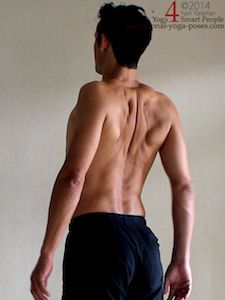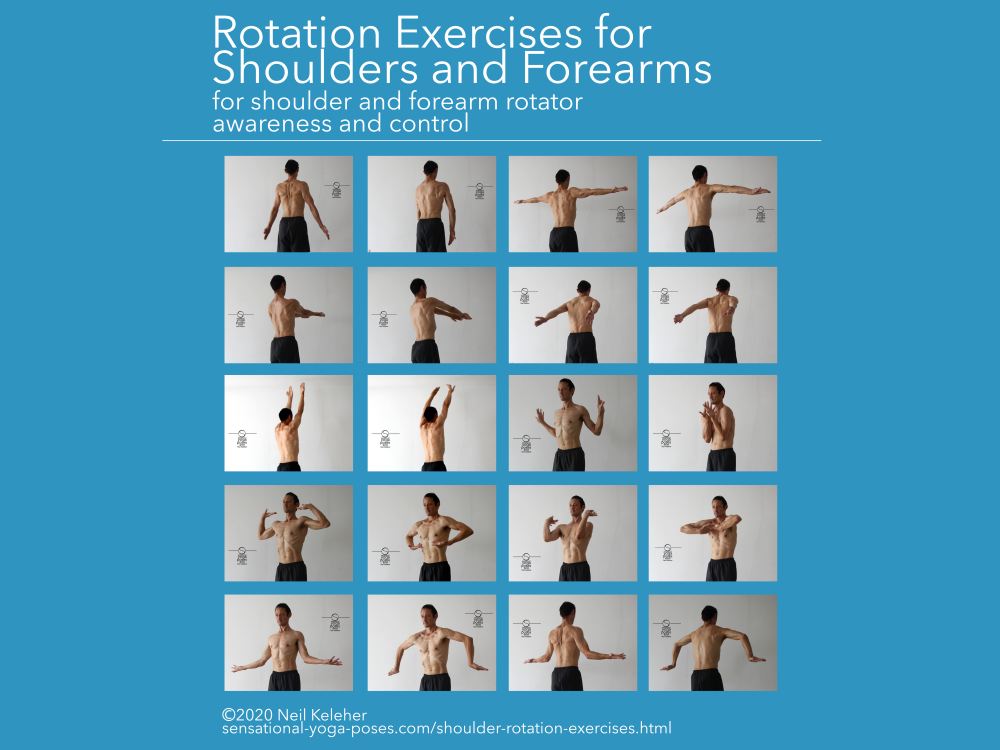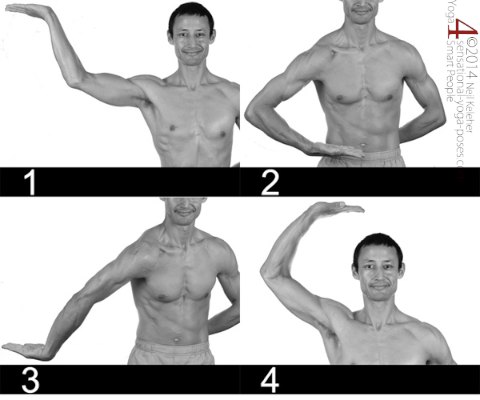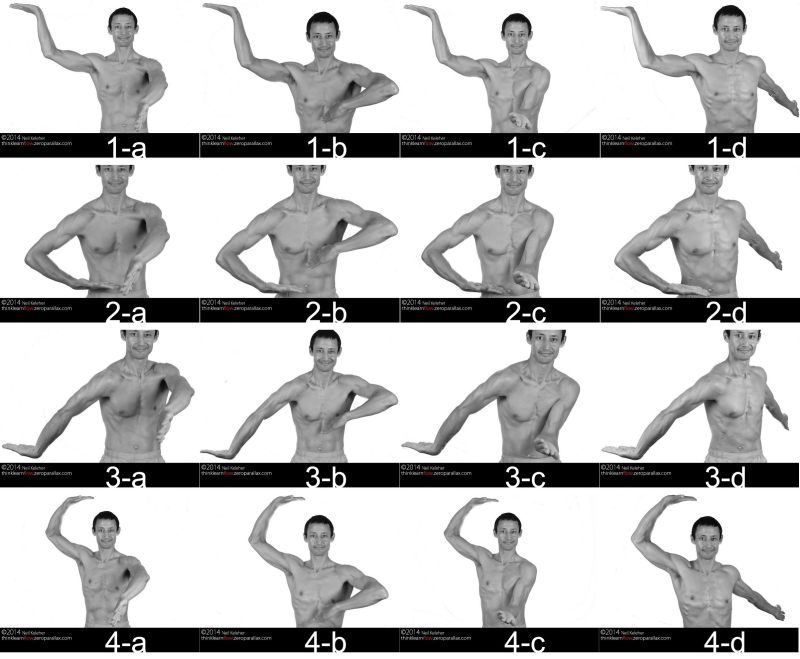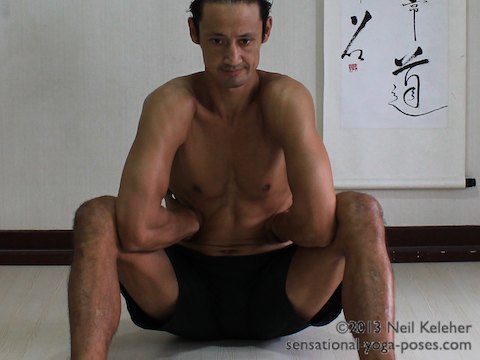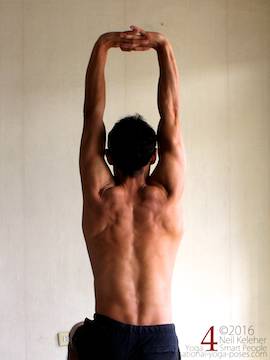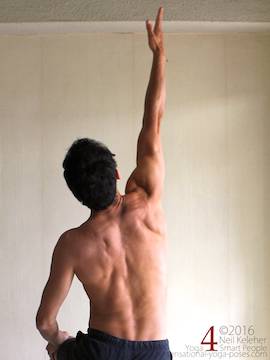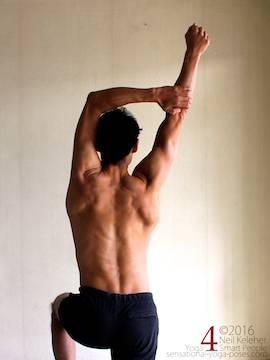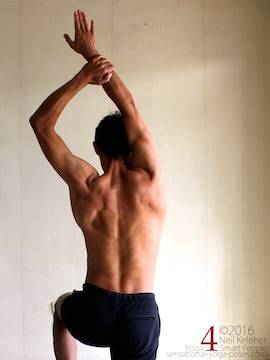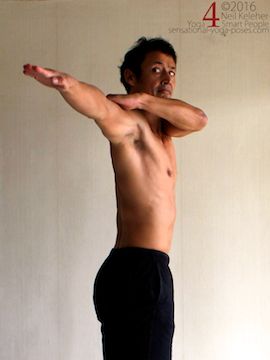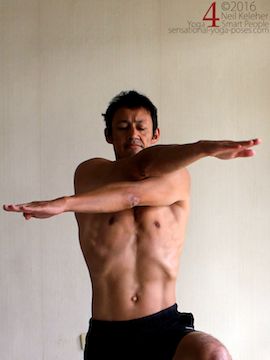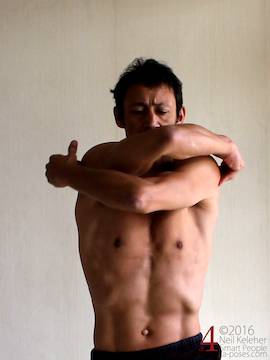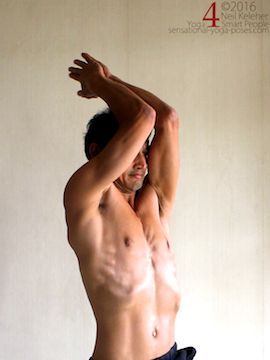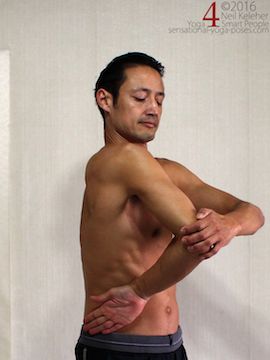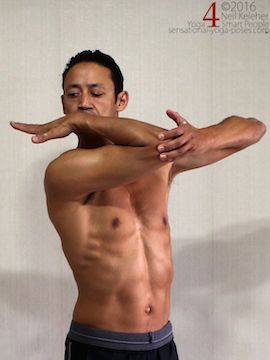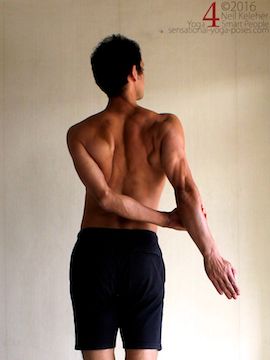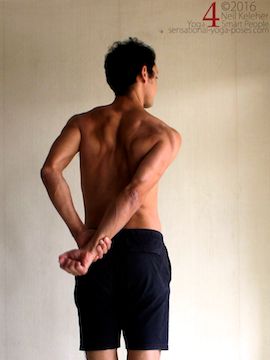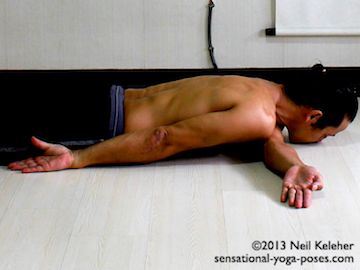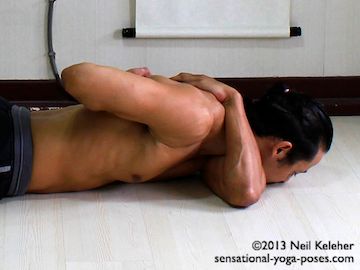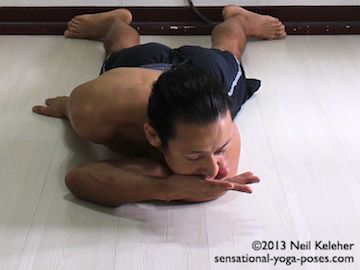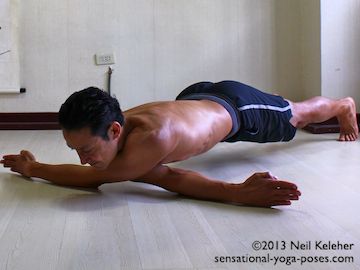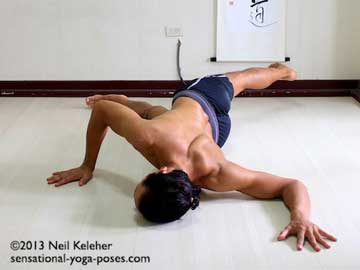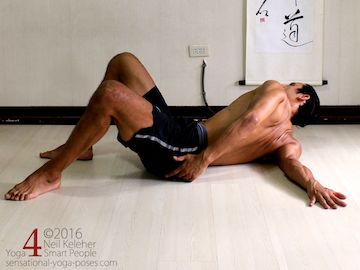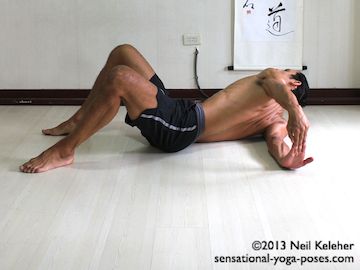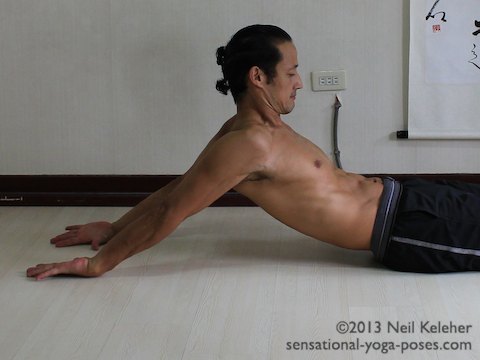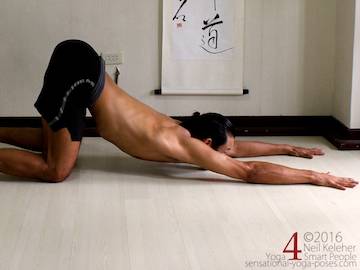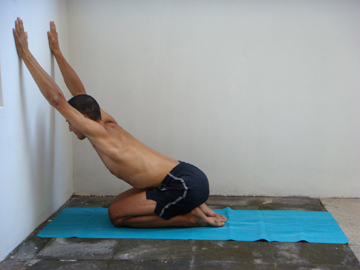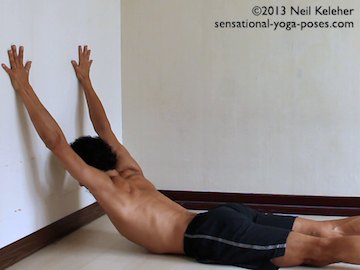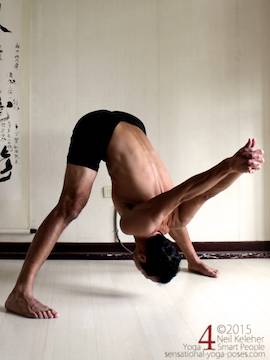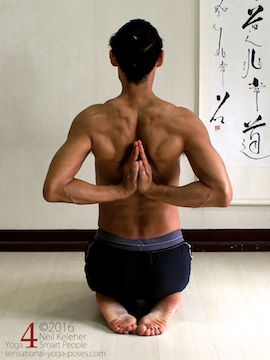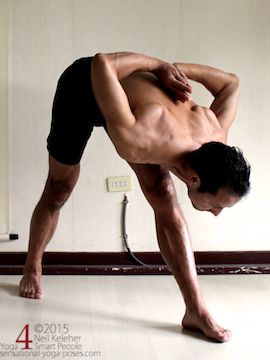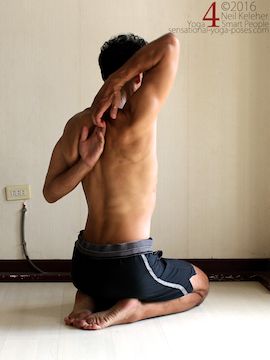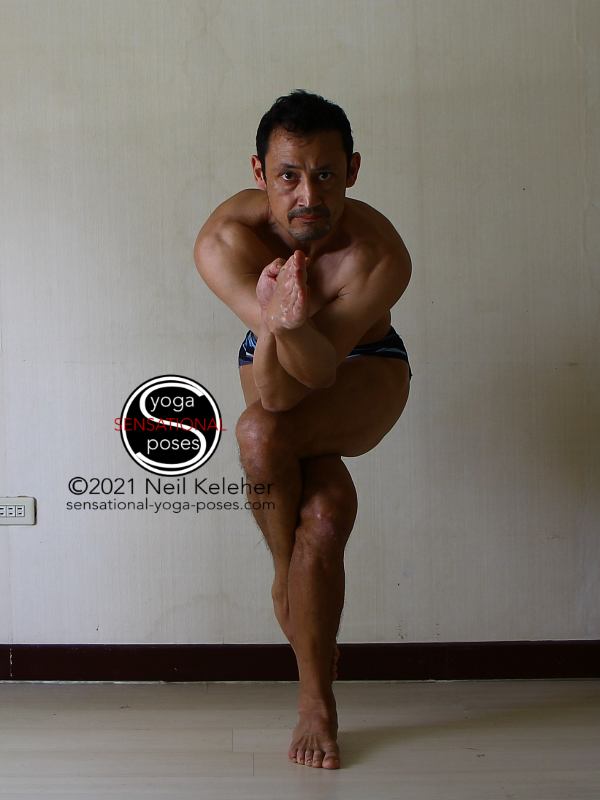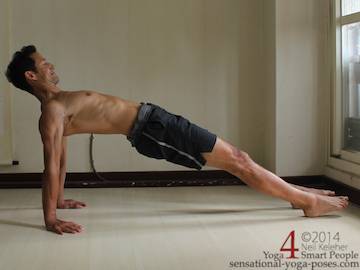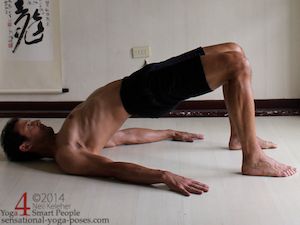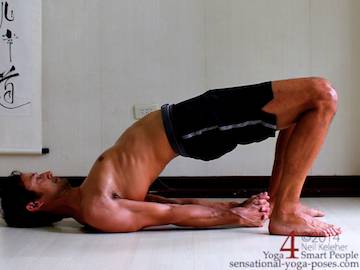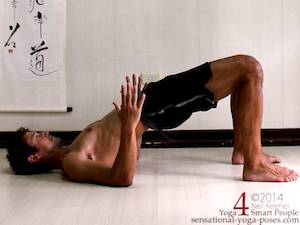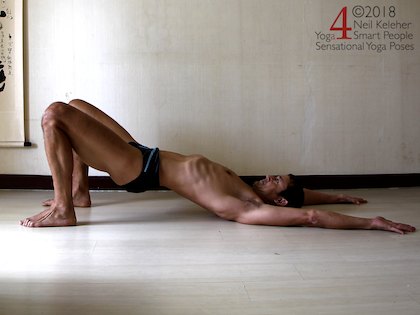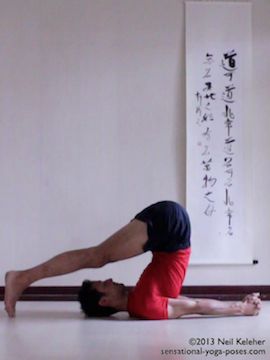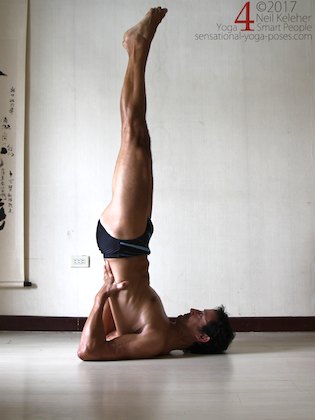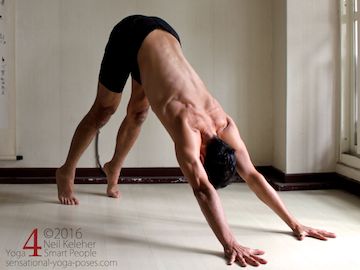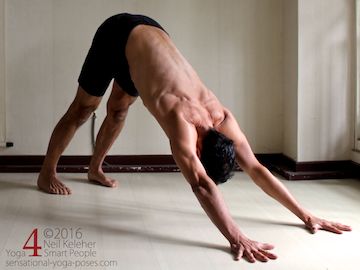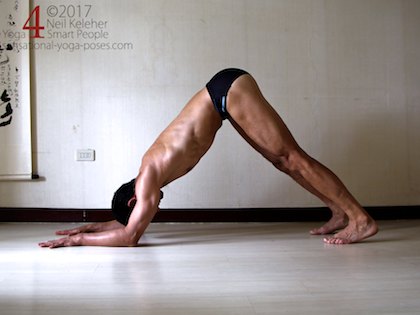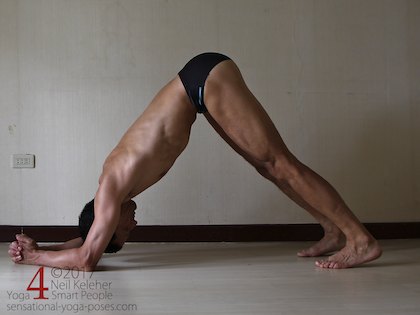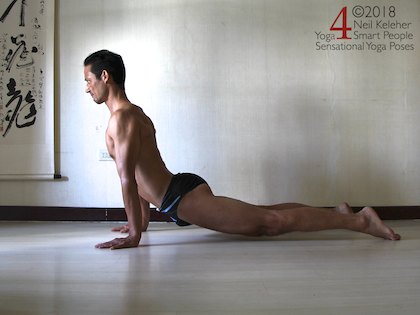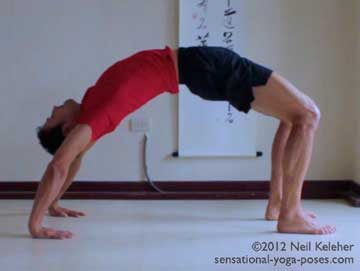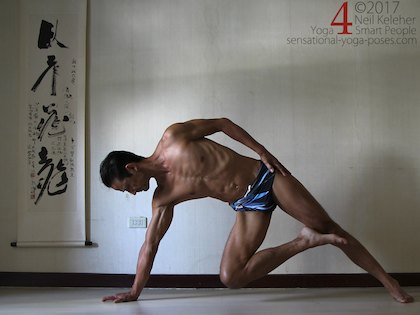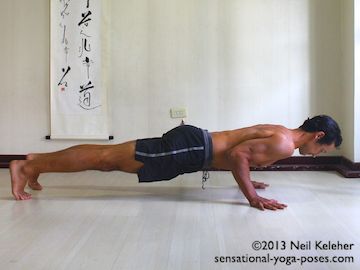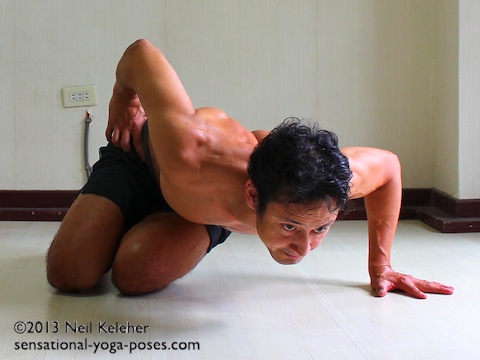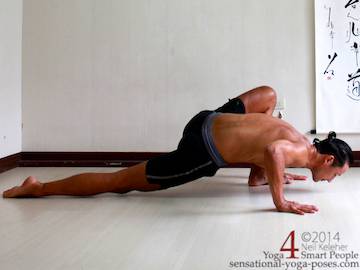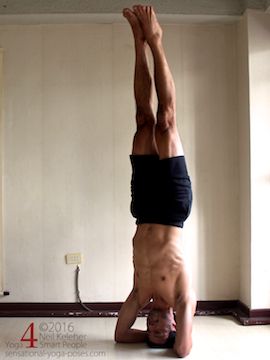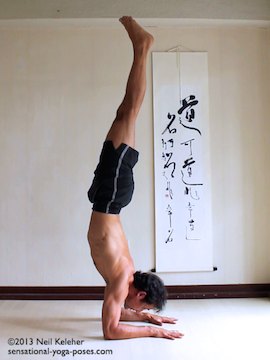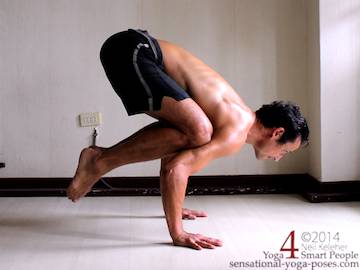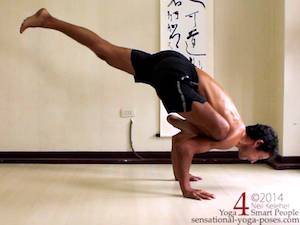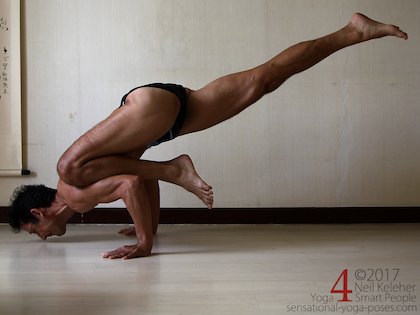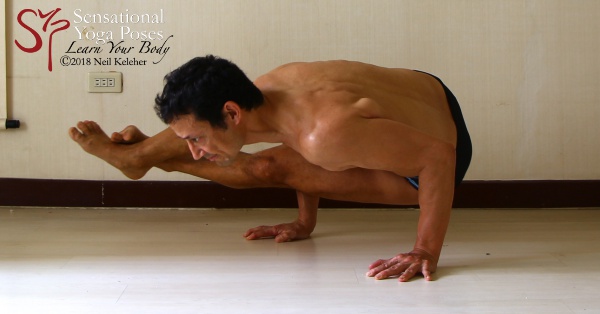An important aspect of developing shoulder control can be that of learning to feel the ribcage as explained in thoracic mobility and also in ribcage mobility. Note, an important aspect of working with the shoulders and arms is learning to stabilize the ribcage. From there you can work on distinguishing movements of the ribcage and the shoulders from each other. This isn't the end goal but rather an intermediate step so that you have control and awareness of both body parts. They can then be used more effectively together.
Ribcage stability and mobility for more applicable arm strength
with Simple Spinal Bending and Twisting Exercises
The importance of the abs, intercostals, spinal erectors and more
One way to start a shoulder yoga practice is to start with shoulder awareness exercises, particularly exercises that improve scapular awareness. This generally involves moving, and feeling the shoulder blades (and collar bones) move, relative to the ribcage.
As part of the process of learning to feel the shoulder blades it can be helpful to learn the reference points or landmarks of the shoulder blades as explained in shoulder anatomy, particularly ones that you can feel or palpitate with the other hand.
Muscles that help move, control and stabilize the shoulder blades relative to the ribcage include: serratus anterior, (for more on this you can also read serratus anterior muscle), trapezius muscle, pectoralis minor and the rhomboids.
Shoulder blade awareness exercises can start with fairly relaxed movements of the shoulder blades without the arms bearing weight and then move towards shoulder yoga poses where the arms are bearing weight. For more on scapular stability in poses where arms are bearing weight read scapular stabilization.
As well as practicing scapular control within yoga poses, another way to practice scapular awareness is in the context of dance of shiva movements. You can read more about how to do that in Practice scapular control with dance of shiva.
Getting a Better Feel for Your Shoulder Blades
scapular stabilization exerises for yoga
The Rotator Cuff, Anatomy Trains and Tuned Tension
Using it to help position your shoulder blades relative to your ribcage
for Improved Body Awareness while doing Yoga Poses
Using it with arms lifted (And controlling it with the arms down)
Anchoring the front of the shoulder blade against upward pulling
Whether or not the arms are bearing weight, the more you learn about your shoulders the more important elbow stability and control becomes. While stiffening against bending or straightening can be important, I'd suggest that even more important (in part simply because of lack of awareness of this possibility) is stabilizing and controlling elbow rotation, both when the arms are straight and when they are bent. For more on the anatomy of forearm rotation (which could be thought of as "elbow rotation") you can read Elbow joint anatomy for yoga teachers and arm-stability.
Stabilizing the Shoulders from the Ground Up
For Handstand, Chaturanga and Other Arm Supported Poses
When improving shoulder awareness, an important idea is that in order to control movement of your shoulders you have to be able feel them move. And so a simple way to improve awareness is to practice moving the part you are learning to be aware of in relative isolation. And towards that end it can help to have a basic understanding of what movements the shoulders are capable of. One such movement is movement of the shoulder relative to the ribcage. That's talked about a bit more in shoulder anatomy 2. Another movement is rotation of the upper arm bone, the humerus, with respect to the shoulder blade. The anatomy is covered in rotator cuff anatomy.
The Rotator Cuff, Anatomy Trains and Tuned Tension
And other Muscles That Rotate The Shoulder
A set of basic exercises for practicing both shoulder rotation and forearm rotation is included in Shoulder rotation exercises.
As well as being useful for practicing shoulder blade awareness, dance of shiva can also be used to practice shoulder and forearm rotations.
In Positions 1 and 4 the focus can be on external shoulder rotation while in positions 2 and 3 the focus can be on internal shoulder rotation.
As for forearm rotation, positions 1 and 2 can be used for external forearm rotation while positions 3 and 4 can be used for internal forearm rotation.
There are 4 other arm positions so that when using both arms there are a total of 64 possible positions.
You can see 16 of those positions below.
The goal is to learn how to connect each of these positions to each other.
For more on this practice, read the dance of shiva.
The arm and shoulder stretches below are roughly divided into three groups (though there may be overlap). Muscle drive stretches use muscle power to create the driving force. Gravity driven stretches use gravity as the main driving force. Yoga shoulder poses are the more "traditional" arm and shoulder positions that are used to stretch the shoulders.
For Stretching Chest and Shoulder Muscles
Active stretches for Improving Shoulder Flexibility and Strength
Using Yoga Pose Arm Positions to Stretch the Arms and Shoulders
Two options for stretching the arm in front of the body that aren't gravity assisted are penguin pose and the cross leg arm stretch.
The cross leg arm stretch can be really nice for stretching between the shoulder blades.
Details on these two stretches can be found in arm stretches.
One simple way to stretch the arms with arms over head is to reach the shoulder (or shoulders) up. Whether using one arm or both, you can also reach up with the sides of the ribs.
An option if you grab one forearm with arms over head is to pull the straight arm outwards or inwards. In either case, resit the pulling arm.
An option for stretching the arm in front of the throat is to grab the opposite arm and pull the grabbing hand back by moving the grabbed arm back.
If crossing the arms in front of the body with both arms straight, you can use your arm and shoulder muscles to move deeper into the stretch.
If you cross both arms in front of your chest, bend your elbows and grab the backs of your shoulders, you can use your fingers to help drive this shoulder stretch.
If, with elbows bent, you touch your palms together over your head, you can turn this into a shoulder stretch by moving the elbows towards each other and back.
You can do a penguin like shoulder stretch one arm at a time by grabbing the elbow of the arm you are stretching as shown below. A possible counterpose is to place the hand of the arm being stretched against the shin instead of against the belly.
One way to stretch the shoulder with a hand behind the back is to reach it towards the opposite side waist, then use the opposite hand to pull it forwards.
Another way to stretch the arms behind the back is to grab the forearm of the straight arm and pull it outwards and then inwards, in either case resisting the pull with both arms.
For more details on the above stretches, read the shoulder stretches page.
One way to stretch the shoulders arms to make it easier to use the shoulders across a wider range of positions is via gravity assisted shoulder and arm stretches. While these are gravity assisted, there is still an element of control and as in any stretch, you do need to anchor one end of the muscle or muscles being stretched.
To stretch the shoulder with the arm crossing in front of the body (in front of the throat) you can use half dragonfly or clasped half dragonfly.
Another option is the pose shown below which Andrey Lappa refers to as "lotus for the arm". Beside it is the full dragonfly shoulder stretch.
You can stretch the chest and the shoulder with the arm out to the side using the bent elbow benittasana stretch, shown below.
You can stretch the shoulder with the straight arm out to the side in lapasana. An option is to grab the hand behind the back while doing this pose.
A pair of poses that you can use to stretch the arms behind the back and then up and back (over the head) are rack pose and puppy dog stretch.
Two poses that you can use instead of puppy dog are these two "spiderman wall stretch" shoulder yoga positions. The kneeling option gives you a bit more control.
For more detailed instruction for all of these stretches, visit the arm stretches page.
Unweighted yoga pose arm actions (yoga shoulder stretches) include grabbing the hands behind the back (and lifting them). This posture is known as dwikonasana. But it's also the arm position used in prasaritta padotanasana C.
Another unweighted shoulder yoga pose is reverse prayer or prayer behind the back. This is the hand position used in the pose called parsvotanasana.
The arm element from the yoga pose called "cow face" can also be done by itself as a shoulder yoga pose.
One other shoulder yoga position is the eagle pose arm position which can be done by itself or with the legs interlaced for eagle pose.
You can read detailed instructions for all of these poses in yoga shoulder stretches.
As covered in scapular stabilization, you can still practice scapular awareness and control while doing yoga poses while the arms are weight bearing. These types of poses are also covered in arm supported yoga poses.
scapular stabilization exerises for yoga
A variety of poses for balanced arm and shoulder strength
Extending the hips and retracting the shoulder blades
and Making it Less Unlikeable
Strengthening the Back of the Spine and Legs
Backbending the Hips, Lumbar and/or Thoracic Spine
To Clench or Not to Clench the Buttocks?
Learning with a wall, working towards not using a wall
Rolling Your way into Shoulder Stand
Getting Your Hips Up and Your Legs Over Your Head
Creating a Sensational (and low back friendly) upward facing dog
Actively Stretching Calfs and Shoulders
Progression for Shoulder, Ab and Leg Strength
A first principles approach to learning to lift your body
Alignment and Using Force Effectively
You Can Be Stronger Than You Think!
Yoga pose progressions for improving arm strength
One of my favorite exercises to practice isolating and then integrating shoulder and ribcage movements is table top yoga pose.
A similiar pose in that the arms are also behind the back is reverse plank yoga pose (which is also known as purvottanasana)
A simple pose where the shoulders can be exercised while laying on the back is bridge yoga pose. In this pose the shoulders can be retracted so that they press down against the ground causing the ribcage to lift up.
This pose can be done with hands free, or hands clasped behind the back.
Other options include bending the elbows with forearms vertical. In this case you can press the elbows down into the floor. You could also support the back of your waist with your hands (not shown). If you want to use this as a prep for wheel pose then another alternative arm position is to reach the arms back.
For more detailed instruction on bridge pose read: bridge yoga pose and/or bridge pose.
Two poses that are similiar to bridge pose in the way that you can use your shoulders against the floor are plough pose and shoulderstand.
One way to get comfortable with shoulder stand (and plough pose) is to practice Shoulderstand using a wall. From there you can work towards doing shoulderstand without a wall as explained in salamba sarvangasana. You can likewise work towards plough pose without using a wall as explained in plough pose.
With shoulder stand your hands are generally placed against the back of your waist while in plough the general instruction is to clasp the hands behind the back. In either case you are effectively creating a bind.
I'd suggest that for strong shoulders, even if you can clasp your hands, and even if you can comfortably get your hands to the back of your waist, in either case, practice moving your shoulders together without using your arms. In each case work at using your shoulder blade retractor muscles, your rhomboids and to an extent your trapezius, to draw your shoulders blades together.
This will have the effect of lifting your ribcage off of the floor. In addition, it will help to anchor your shoulder and arm muscles possibly making it easier to grab the hands in plough pose, or use them to support the back of your waist in shoulder stand.
Note that because the neck is bent forwards in both poses, it may help to use the latissimus dorsai and/or the lower trapezius to help exert a downwards pull (towards the pelvis) on the outer and/or inner edge of the shoulder blade. This can then help to anchor the levator scapulae and/or the upper trapezius so that the can help support the neck in this forward bent position.
For more on the relevant anatomy you can read trapezius muscle and latissimus dorsai.
In downward facing dog the arms reach past the head. This pose could potentially be used as a preparation for wheel pose. If you want to stretch the front of the shoulders and equivalently reach the arms back by sinking the chest, make sure that you keep your shoulders active. One way to do this is to push your ribcage back, away from your hands.
This pose can be done with knees bent allowing you to focus on your shoulders and spine.
It can also be done with knees straight and heels lifted or with knees straight and heels down.
For more on downward dog, read downward facing dog.
A pose that is roughly similiar to downward dog is dolphin pose. The main difference is that in dolphin pose the elbows are bent with the forearms on the floor.
As with downward dog you can do this pose with knees bent of with heels lifted. Options for the arms can include doing it with hands unclasped (and forearms parallel) or with hands clasped.
Read more about dolphin yoga pose
In upward dog you could work at protracting your shoulder blades, and then pull your shoulders down relative to your ribcage (which, since your hands are on the floor, will cause your ribcage to move up). Another option you can use, either in isolation or in combination with those actions is to pull your hands back, against the floor to exert a forward pull on your ribcage.
Read more about upward facing dog.
Wheel pose is perhaps one of the more challenging shoulder yoga poses. Some suggestions for working towards wheel pose can be found here: wheel pose.
Side plank can be done with elbow bent or straight but in either case you can learn to stabilize your shoulder blade. With elbow straight you could also work on elbow joint stability.
To learn how to stay balanced in side plank read balancing in side plank.
For various side plank options read side plank.
With bent arm poses like chaturanga dandasana, which you could think of as a yoga push up, the challenge is to support the weight of the body with elbows bent. Shoulder and elbow stability are both important as is scapular stability. That being said, you can read about different ways to at least get your body off of the ground in chaturanga and chaturanga dandasana and yoga push ups.
And for more options for working with bent arms, check out arm strengthening exercises.
Working towards balancing while upside down
Preparations and Getting Used to Being Upside Down
Creating Stability So You Can Find Balance In
How to Lift Into a Headstand with Straight Legs
Balancing Between the Elbows and the Hands
How Do You Peel Your Feet off of the Wall (and Balance)?
Improving Your Arm Balance From Beginner to Advanced
Using Hip Tension to Create Lift and Stability
Getting your feet off of the floor without jumping
Inverted yoga pose are another type of yoga pose where the arms or shoulders bear some or all of the weight of the body.
I've already mentioned downward dog, plough pose and shoulderstand.
In headstand, as well as using the neck you can use your shoulder and arms (and elbows) to help support the weight of your body.
Read more about it in how to do a headstand and headstand yoga pose. For how to learn to lift into headstand with legs straight read yoga headstand.
Another inverted yoga pose is pincha mayurasana. In this pose you balance on your forearms.
Read more about it In pincha mayurasana.
Then there's handstand. A good starting point to learn this is with L-shaped-handstand using a wall. Rather than looking at external alignment, work at feeling how your center relates to your hands. For more on handstands you can read balancing in handstand, kicking up into handstand and jumping into handstand.
In arm balancing yoga poses, the weight of the body is in part supported by resting part of one or both legs on the back of one or both arms. This makes shoulder and elbow stability a little less critical though both can still be important. One of the most basic arm balances is crow pose.
But there's also galavasana which could be thought of as flying pigeon.
And there's eka pada bakasana which could be thought of as single leg crow pose.
There's also an easy arm balance where the legs scissor the supporting arm. It's called Astavakrasana and you can find out more about it in astavakrasana yoga arm balance.
For even more on arm balancing (and more arm balancing options) and arm balances, read arm balances.
Yoga Shoulder Exercises and Stretches includes a systematic approach to shoulder awareness and flexibility
Published: 2015 07 12
Updated: 2020 11 06
